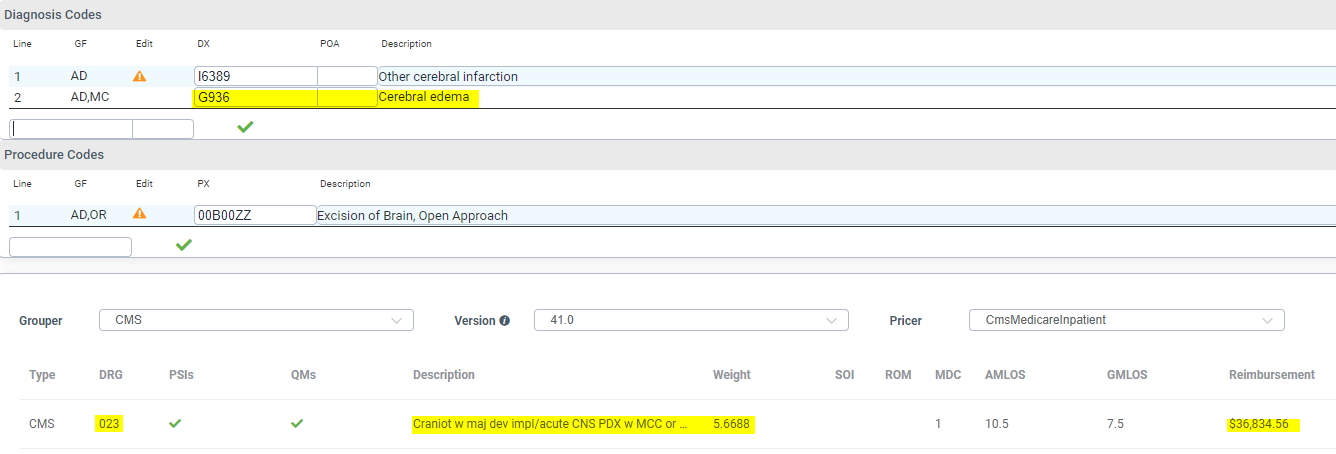
A common misconception among coders is that cerebral edema is a symptom of another condition and therefore it cannot be coded. However, this is not the case. Cerebral edema is a significant condition of its own and as long as there is clinical documentation and treatment/monitoring supporting cerebral edema, it can and should be code.
Conditions that Precipitate Cerebral Edema
Cerebral edema is often precipitated by or found to accompany other serious diagnoses that cause the brain to swell, such as
- Traumatic brain injury (TBI)
- Ischemic stroke
- Hemorrhagic stroke
- Infections
- Meningitis
- Encephalitis
- Toxoplasmosis
- Subdural abscess (empyema)
- Tumors
- High altitude sickness
A Diagnosis of Cerebral Edema Impacts the MS-DRG
Cerebral edema is an MCC. It is important for the coder to capture this diagnosis so the codes on the claim submitted for reimbursement accurately reflect the resources expended to treat the patient.
Consider the comparison below. Note the significant change in relative weight and expected reimbursement when a code for cerebral edema is assigned as a secondary diagnosis designated as an MCC.
MS-DRG 024 CRANIOTOMY WITH MAJOR DEVICE IMPLANT OR ACUTE COMPLEX CNS PDX WITHOUT MCC
- Relative Weight: 3.7888
- Reimbursement: $24,618.75

MS-DRG 023 CRANIOTOMY WITH MAJOR DEVICE IMPLANT OR ACUTE COMPLEX CNS PDX WITH MCC OR CHEMOTHERAPY IMPLANT OR EPILEPSY WITH NEUROSTIMULATOR
- Relative Weight: 5.688
- Reimbursement: $36,834.56

What if Cerebral Edema is Not Specifically Documented?
If clinical indicators for cerebral edema are present in the record, particularly in the setting of an often-related serious diagnosis, but cerebral edema is not explicitly documented, the coder should pose a query for clarification.
According to the AHIMA and ACDIS’ joint publication Guidelines to Achieving a Compliant Query Practice, clinical indicators are, “…documentation that supports a diagnosis as reportable and/or establishes the presence of a condition. Examples of clinical indicators include (but are not limited to): provider observations (physical exam and assessment), diagnostic tests, treatments, medications, trends, and consultant documentation authored by providers and ancillary professionals documented throughout the health record”.
Clinical indicators of cerebral edema include the following:
Symptoms
- Headache
- Neck pain or stiffness
- Nausea or vomiting
- Dizziness
- Irregular breathing
- Vision loss or changes
- Memory loss
- Inability to walk
- Difficulty speaking
- Stupor
- Seizures
- Loss of consciousness
Diagnostic Tests
- Physical exam of head, neck and nervous system
- Radiologic exams (CT/MRI)
- Blood tests
Treatment
- Oxygen therapy
- IV fluids
- Lowering body temperature (hypothermia)
- Medication - A listing of additional medications used to treat cerebral edema can be found here: Compare Current Cerebral-Edema Drugs and Medications with Ratings & Reviews (webmd.com)
- Decadron (Dexamethasone)
- Mannitol
- Osmitrol
- Solu-Medrol
- Depo-Medrol
- Kenalog
- Cortef
- MethylPREDNISolone
- Betamethasone
- Ventriculostomy
- Surgery
- Craniectomy to relieve intracranial pressure
- Procedures to address the source of the swelling
Take Aways
Cerebral edema is a clinically significant diagnosis often found to be precipitated by other serious conditions as listed above. Cerebral edema is designated as an MCC, so its assignment as a secondary diagnosis can substantially impact the relative weight of the DRG for an inpatient admission. There are numerous clinical indictors suggestive of cerebral edema. When documented in the health record with no accompanying diagnosis of cerebral edema the coder should query the provider to determine whether assignment of a code for cerebral edema is appropriate.
For more detailed information about coding for cerebral edema, including discussion of specific types of cerebral edema and how they are coded, diagnoses that are not cerebral edema, a sample query and additional resources take the HIAlearn course, Cerebral Edema Overview: Types, Causes, Diagnosis, Treatment and Coding.
References
HIALearn Cerebral Edema Overview: Types, Causes, Diagnosis, Treatment and Coding
AHIMA/ACDIS Guidelines for Achieving a Compliant Query Practice
WebMD Medications for Cerebral Edema
Cerebral Edema (Brain Swelling): Symptoms, Causes, & Treatment (webmd.com)
Since 1992, HIA has been the leading provider of compliance audits, coding support services and clinical documentation audit services for hospitals, ambulatory surgery centers, physician groups and other healthcare entities. HIA offers PRN support as well as total outsource support.
Subscribe to our Newsletter
Recent Blogs
Related blogs from Industry News , Medical Coding Tips
Complex coding scenarios often lead to delays...
Provider documentation is the foundation of a...
Accuracy is the foundation of quality coding....
The 2026 updates to CPT and the Hospital Outp...
Subscribe
to our Newsletter
Weekly medical coding tips and coding education delivered directly to your inbox.


.png)



